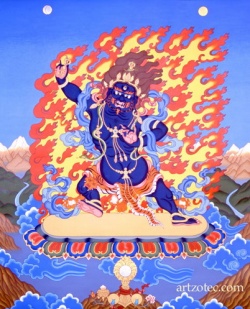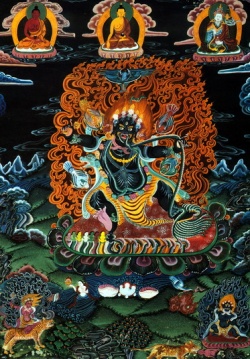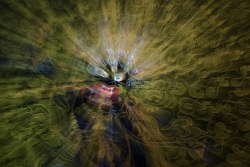Vajrapani Buddha Mantra
For those who are new to Buddhism, Vajrapani doesn’t seem to have the appearance of a Buddhist bodhisattva, at all. A Bodhisattva is a person who is on the cusp of enlightenment but has the knowledge needed to become wholly enlightened, happy, and free from suffering. A bodhisattva typically takes a vow to remain on earth in order to help as many sentient beings as possible with their own journey to enlightenment. They also typically are reincarnated as those who become great spiritual leaders.
Vajrapani represents all of the energy of a mind that is enlightened, and the mantra associated with him is also symbolic of that quality. Some who are not as familiar with Buddhism may wonder how a bodhisattva who is depicted as looking so very wrathful and angry can be associated with the peacefulness and pursuit of happiness that Buddhism is often thought of as being. This is definitely one of those situations where it isn’t wise to take things at face value, because Vajrapani is devoid of negative feelings and emotions.
In illustrations and texts, Vajrapani is depicted as dancing wildly inside of a halo of flames. This is said to be representative of the state of transformation. In his right hand Vajrapani is shown to be holding a vajra, which is a thunderbolt. The vajra is representative of having the power that is needed to cut right through the darkness that delusion brings with it. While illustrations and statues of Vajrapani may appear to be wrathful and otherwise angry, the truth is that as a representation of the bodhisattva mind that is enlightened, Vajrapani is completely free from any feelings of anger or hatred.
Vajrapani’s mantra is very simple for those who are interested in beseeching this important deity to help provide their lives with the guidance needed to overcome obstacles and eliminate suffering. The mantra is as follows.
Om Vajrapani Hum
The mantra for Vajrapani is simply his name, framed in between the two syllables that hold mystical strength in Buddhism, Om and Hum. Vajrapani’s name can be translated to mean “wielder of the thunderbolt.” By repeating this mantra we can gain an access to the type of irrepressible energy that is symbolized by Vajrapani. Think of it as a means of tapping into his endless energy in order to receive strength, guidance, and to eliminate our suffering. The mantra has an upbeat and energetic feel to it, which is only strengthened with a greater insight into Vajrapani himself.
Vajrapani belongs to the trinity of bodhisattvas who are collectively known as the Three Family Protectors. The other two bodhisattvas in the trinity are Manjushri and Avalokiteśvara. Vajrapani also belongs to the Vajra family, which means the thunderbolt family, and Vajrapani is the protector of the Vajra family of Buddha. Some of the Buddhas within the Vajra family include Yamantaka and Akshobya, who is the lord of the Vajra family group.
The wrathful appearance of Vajrapani disguises his true nature. Figures who are wrathful in appearance actually appear very often in the various schools of Buddhism, particularly the Vajrayana and Mahayana traditions. It is important to be reminded of the fact that it is not really possible to adequately represent the true qualities of enlightenment in an image or statue. This means that even the most peaceful representations of the Buddhas and the bodhisattvas could be considered to be misleading. Because of course those who are enlightened do not sit around on lotuses or elephants looking serene and content. Even the Buddha himself was intensely active in engaging with other spiritual leaders and the philosophers he encountered in his day-to-day life. The Buddha had a fearless approach to life, which meant that he was just as likely to be reflecting on his pursuit of truth and happiness as he was to be diffusing challenging situations.
This means that it can be just as appropriate to depict someone who is enlightened as being fearless while dancing wildly in a hoop of fire. Consider the way that the Buddhas and other enlightened beings are typically represented and think about them being a true representation of how we wish our lives could be; living ethically, meditating, eliminating our suffering, and seeking out our own pathway to happiness. The reality is however is that there are always going to be some parts of us that are deeply and profoundly threatened by the possibility of change that enlightenment brings to us.
We become complacent with the suffering that we are living with. The habits that are contributing to our suffering, like craving and denial, can take on almost a life of their own and try to control our path to true happiness. From the viewpoint of the parts of ourselves that are complacent and settled with the idea of this suffering being a part of our lives, the idea of enlightenment can seem frightening and wild, and almost demonic.
Because of dual nature that we all have within us, Vajrapani is also recognized and depicted in some of his more peaceful forms. So while he may most often depicted as being wrathful and rather frightening in appearance, he is also depicted as being muscular, athletic, with a peaceful demeanor and face.
In earlier depictions of Vajrapani, he is shown as being a powerful and muscular figure that is standing beside the Buddha to offer him protection. In the later forms, there is a shift toward the more ethereal appearance for Vajrapani and he is shown as being dark blue in color. This is thought to perhaps come from the color of Akshobhya, who is the lord of the Vajra family. But it is also important to note that the dark blue color is also the color of a thunder cloud.
Vajrapani is shown both nude and also wearing a loin cloth; the loin cloth is said to be made from the skin of a royal tiger. Atop his head is the five-pointed crown of the bodhisattva, with five skulls on the crown. A necklace around his neck hands down to his belly, and a snake is also draped around his neck. The snake is said to be symbolic of Vajrapani’s association with rain and clouds, which fits in with Vajrapani’s origins as one of the thunder gods.
Vajrapani represents all of the energy, power, and fearlessness of all of the Buddhas. In his right hand he holds a vajra, while in his left hand he holds a lasso that he is said to use to bind demons responsible for suffering. Remember that while Vajrapani and other similar figures in Buddhism are described as being wrathful, it is important to recognize that they are not representative of anger as we think of it. They are representative of the fearlessness and power that comes from a mind that is awakened.


